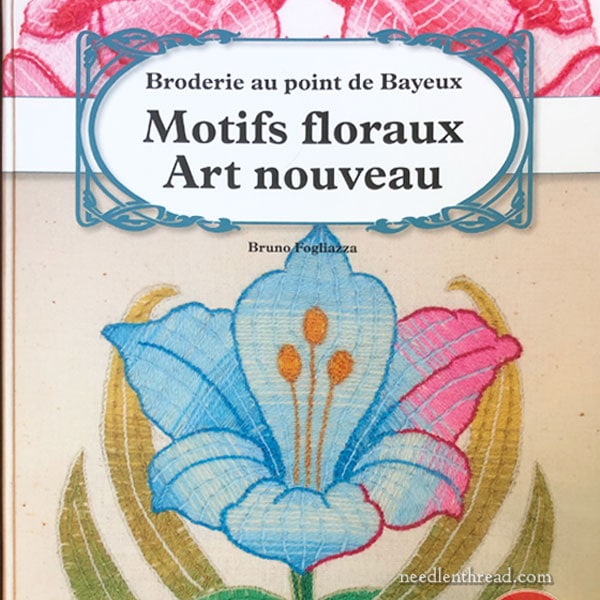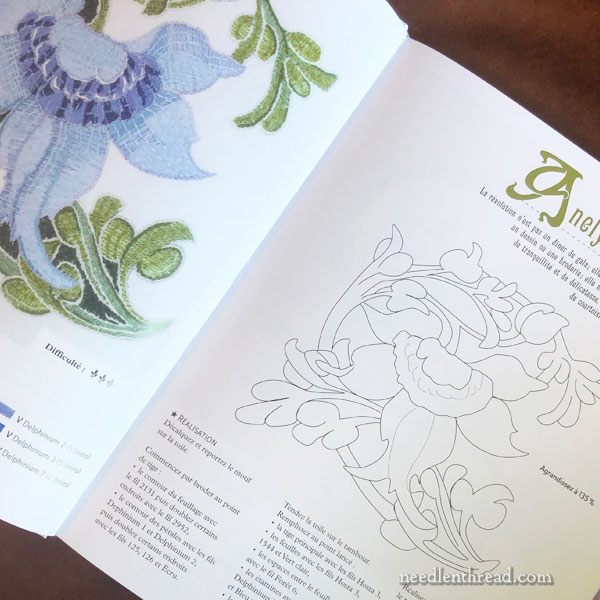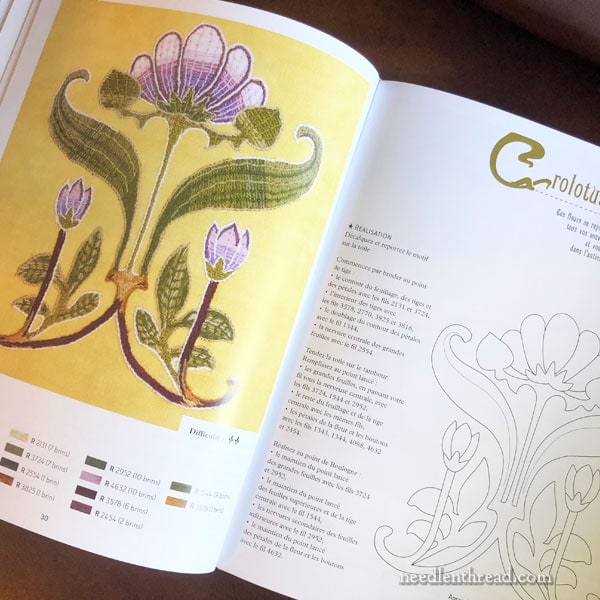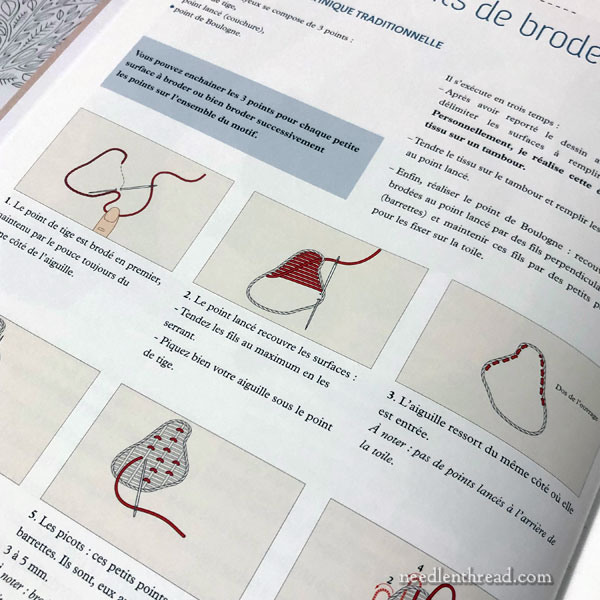The history of art is marked with specific eras of design styles. One short-lived era that doesn’t get a whole lot of attention in the hand embroidery world these days (though it is gaining popularity again) is the Art Nouveau era, which lasted – at its height – only about 20 some odd years, from the end of the 1800’s through the early 1900’s.
The style had its origins in the Arts and Crafts movement, but the features of Art Nouveau design can be isolated and made distinct from the design of the Arts and Crafts movement. Much more “modern” in execution, what we call Art Nouveau in general today was known by many different names at the time, including Style Moderne in France, “Tiffany style” in the States (think: the stained glass of Louis Comfort Tiffany), and, in the UK, “Modern Style” or “Glasgow Style” (after the Glasgow School of Arts). Throughout Europe, each country had its own name for the distinct style of the Art Nouveau age. Considering its relatively short-lived (but a bit frenzied) popularity, the style spread and was adopted very quickly around the globe.
The Art Nouveau style extended into not only the fine arts, but also the applied arts, so you’ll find not only paintings and sculptures in Art Nouveau style, but you’ll also find extant examples of stained glass, jewelry, metal, textiles, furniture, architecture, mosaics, and all kinds of applied, decorative artwork made during the era.
I like the Art Nouveau style. It’s so clean. It strikes me as a perfect fit, too, for the “minimalist” approach to a lot of decor these days.
But enough about the history part of things! Let’s talk about this book: Motifs Floraux Art Nouveau, or Art Nouveau Floral Motifs. I know there are a lot of embroiderers out there who are also Art Nouveau enthusiasts, so I thought this book would be of interest!

You’ve probably already figured out that the book in question is in French. This can cause a few little set-backs if you don’t speak or read French – we’ll talk about those below and how to overcome them.
The book is full of single motifs in the Art Nouveau style, ready to be embroidered. The embroidery is primarily done in Bayeux stitch. The combination of what was essentially a medieval embroidery technique with a very modern design style is interesting! The somewhat linear nature of the Bayeux stitch coupled with the neat lines of Art Nouveau produce a very modern effect overall.
That said, the designs can be interpreted in any type of embroidery technique. They’d look great in silk shading. They’d look great in goldwork. They’d look great in whitework. Blackwork, crewel work… they’re good designs that would interpret across a variety of embroidery approaches.

Each design is presented as a line drawing in the book, with an indication of how much it should be enlarged when copying it.
To enlarge a design that you’re photocopying, the easiest method is to place the page face down on a copy machine and enlarge by the percentage indicated. Depending on the percentage the image is enlarged, you might have to run a couple test copies, moving the page to different parts of the screen, to get the whole image. Once you have the design printed at the recommended size, it’s just a matter of transferring it according to your favorite method of design transfer.
If you want to work the designs in wool (as presented in the book), most of the designs need to be enlarged, but if you were to do them in silk or cotton, depending on the stitching techniques you wanted to use, most of the designs can be used at the size in the book.

Along with the design, you get a clear image of the finished embroidery, plus a color list of the wools used in the design (this is one of the little hitches that we’ll talk about below), along with a description of the process of the embroidery (the other hitch – the book is in French, remember – but we’ll talk about how to get around that below).

If you want to interpret the designs Bayeux stitch and other similar techniques used on the samples in the book, you’ll find clear diagrams for these techniques at the beginning of the book. They don’t require knowledge of the language to see how to work out the various embroidery techniques.
Pros, Cons, and Overcoming the Language Barrier
The pros:
A very interesting collection of Art Nouveau designs to embroider – along with color schemes for each embroidery, and, if you want them, stitch techniques for the particular approach.
There are a whopping 48 projects in the book!
The designs are clean line drawings and take very little effort to enlarge for embroidery.
The cons:
For English-speaking folks, the book is in French. Still, the parts that you need for embroidering the designs are easily discernible, despite the language barrier. If you need to read anything in the book, a simple tool like Google translate can give you the gist of the message.
The fibers suggested in the book are hard to come by in the States. In fact, there are four different types of wool that they use on the models in the book, and they come from three different sources even in France (you have to shop through three different shops in order to find the four types of wool). I think this is problematic, obviously. On the bright side, you can color match with the photos in the book if you like their color scheme and substitute whatever wool you want to use.
In a Nutshell
For embroiderers who love the Art Nouveau style, this is a great collection of small, individually, manageable motifs. The approach of stitching them with the Bayeux stitch is interesting, but it isn’t essential. I love the color schemes on many of the pieces, but I’d probably approach the stitching on most of the designs that I like with different techniques. There’s a lot of scope for interpretation!
Where to Find It
In the States, you’ll find Motifs Floraux Art Nouveau available here through French Needle.
There are also a few copies available on Amazon, which you’ll find listed on my Amazon Recommendations page here, under “Browse my Amazon Recommendations.”
This article contains an affiliate link to my Amazon recommendation page, which means that Needle ‘n Thread receives a small commission for any purchases made through that link, without any extra expense to you. Thanks!







Hello Mary
What a coincidence – I just received my copy from the French Needle. I love Art Nouveau. The embroidery descriptions are easy to follow. I plan to design some stencils in the Art Nouveau style for my powder room and embroider the flowers from the book to hang on the wall. You did a great review of the book!! Thank you!
If you have the Google Translate app on your phone, you can point your phone’s camera at the page and Google will translate it for you.
Good point! It’s one of my favorite tools! 🙂
Happy Monday!
I had a great time using the Mon Cahier de Brodiere to make a sample book. I don’t see any problem with a language barrier. The book was in French, a small group of us did this as a WIP monthly posting in Spanish what we learned and our interpretation of the design. Google has improved it’s translation. And of course for explanation of each stitch come back to NeedleNThread. We all mostly worked with the colors and threads we had on hand. I used DMC or Anchor for coton and Fine D’Aubusson for wool. I think embroidery breaks the language barrier. Motifs Floraux looks like a fun opportunity.
I agree, Sharon! Not much of a language barrier with most embroidery techniques! 🙂
Mary, your blogs and website are terrific! Not only have you provided a wealth of stitching information, but the background/history is wonderful reading!
Thank you for everything you provide to the readers. You are truly inspirational and re-energizing me in doing handwork! One of these days I will be able to purchase things from your store before they are sold out!
Shucks, thanks, Jane! You can always email me and ask to be on an advanced notice list for the kits or ready-to-stitch towel sets. Just let me know what you’re specifically interested in, and I’ll add you to that email list.
In Italy we call it Stile Liberty or Liberty Style and I am fortunate to not only live in a city full of exquisite examples of Liberty Style art, architecture and statuary but I also get to live in a Liberty Style building so I’m definitely getting this book. The author also has another book, also in French, also using the Bayeaux stitch called L’herbier Médiéval which is based on the Great Hours of Anne of Brittany and is full of fruits, vegetables and bugs of various kinds and looks pretty fantastic.
Oh yes! And the funny thing is, that name – Stile Liberty – comes actually from the UK, specifically from Liberty of London, who produced lots of textile designs in the style. You’re very fortunate in your inspiring surroundings!!
I love Art Nouveau, but the use of Bayeux stitch on these designs threw me. It seems to be fighting the curves and flowing lines of the designs.
LOL! Yes, I know what you mean! I prefer the book for the designs, rather than for the techniques involved!
When enlarging designs, I found it easier to scan it first and then use the custom settings when printing for the exact percentage size that I want. This way you also have it for future use.
Yep, that’s a perfect solution, too!
This is gonna be fun — I’m going to try one of the motifs, first in Bayeux stitch, then in other crewel stitches. I think it can be fun independent study challenge.
Meanwhile, I have worked out the book’s odd recommendation for colors from different shops. I knew about Madame Chantal’s wools, because I have worked 2 of her kits based on the Bayeux Tapestry. Her colors are specially made to her specifications in France to fit neatly with the earthy tones of that famous embroidery. Madame is easy to work with, kind and responsive, and your orders ship very quickly. The wool came in cut lengths nicely braided and did not fray or break or pill.
The other two sources mentioned in the book actually sell the same brand of crewel wool — Fine d’Aubusson. They are handled by Access Commodities, so all are available online from sources like Needle in a Haystack who will help you find the colors your require. However, I was scratching my heard a bit — the d’Aubusson color numbering a bit odd. When a single digit number is called for the color name will also be need. For example color Hosta comes number Hosta 0, 1, and 2 while color forest green comes in Foret 0-6.
Mary I usually appreciate your recommendations but this time I think you got it wrong. The combination of static chunky Bayeux stitch with flowing sinuous art nouveau is a bad idea, badly executed. And the author’s color choices make it even worse. If I had had more of an idea of how bad the actual finished designs are I would not now be stuck with a book I hate.
Yes, I prefer the designs more than the execution. I have all kinds of ideas the embroidery, in a way that would not be as “clunky” – the Bayeux stitch is never the best choice for a flowing design. But the book itself as a pattern book and a springboard is pretty good. I would just change the technique completely, or adapt it. For example, I could see effectively using burden stitch (like I did in Fantasia in Silk – that’s this design), raised stem stitch, and long and short stitch shading (in some designs, with lattice work on top, if you want that layered look) and creating some really striking and beautiful Art Nouveau embroidery. I suppose I should have been a little clearer on using the book as a springboard. “The combination of what was essentially a medieval embroidery technique with a very modern design style is interesting! The somewhat linear nature of the Bayeux stitch coupled with the neat lines of Art Nouveau produce a very modern effect overall. That said, the designs can be interpreted in any type of embroidery technique.” I think the idea behind the book was to kind of bring the Bayeux stitch into a more contemporary use in embroidery, but I, too, don’t think that works well. It’s not meant to be a shaded, flowy technique. It just isn’t structured that way. My plan is to extract the ones I like and re-interpret.
I have to continually remind myself that I don’t speak French. There are reasons! I was forced to watch Canadian Sesame Street. On Canadian Sesame Street, they speak English and French. And little me, young enough to understand the French as easily as the English, hated the sound of French. Eh, tiny versions of ourselves can be odd. But, anyway, some of it stuck in my developing brain. Maybe not the meanings, but the sounds are there. So, I would totally buy this book thinking, “Oh, posh! I can read it!” And then I wouldn’t be able to read it. The end.
Searching for Bayeux stitch, I found https://embroiderersguild.com/uploads/docs-mags/bayeux.pdf from the Embroiderers’ Guild. In case anybody else is curious at this late date.